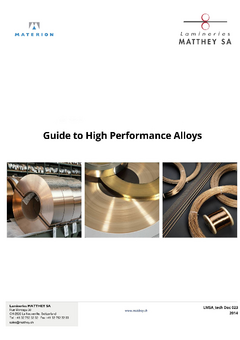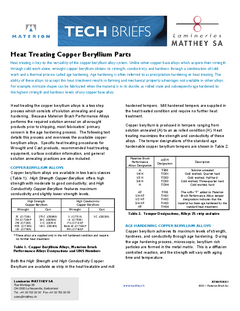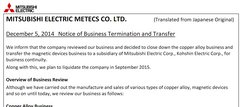Stainless steels
Corrosion resistance had long been the greatest problem for steels, which was solved only after 1910. In order to classify steel "stainless steel", it must contain at least 10.5 % of chromium and less than 1.2 % of carbon. The European standard has two definitions for stainless steel:
- The marking starts with the letter "X", followed by the carbon content x 100, then the chemical symbols for the alloy elements in descending sequence according to their content. The average content of these ingredients is subsequently defined, separated by hyphens in the same descending sequence.
- The numeric designation deriving from the obsolete DIN standard includes 5 digits and commences with 1.4; the third digit relates to a certain type of steel family and reflects the chemical composition.
From a technical point of view, stainless steels are divided into four main groups according to their structure: ferritic, martensitic, austenitic and precipitation-hardenable.
Ferritic stainless steels are iron/chromium or iron/chromium/molybdenum alloys with a chromium content between 10.5 and 28 % and a carbon content not exceeding 0.08 %. These steels normally contain no nickel and harden only by cold deformation.
The martensitic stainless steels or precipitation-hardenable stainless steels typically contain 12 to 19 % chromium and may also contain nickel, molybdenum as well as other additives. These steels exhibit good corrosion resistance, as well as mechanical properties that are equal to those of non-stainless alloyed steels. These properties are achieved after the appropriate heat treatment: Quench hardening and tempering of martensitic steel, quench-hardening and aging for steel with hardening feature. Lamineries MATTHEY offer martensitic steel 1.4034, X46Cr13 in the form of thin, rolled strips.
Among the steel types, austenitic steels are the most popular and are used most. Apart from a chromium content of 17 %, they contain nickel and perhaps molybdenum, titanium or niobium additives. The nickel content enables the austenitic structure that supports corrosion resistance. In fact, the missing second phase - e.g. martensite derived from the deformation or ferrite - promotes corrosion resistance. The addition of molybdenum improves resistance to chloride, sulphuric acid and other organic acids. This is the reason that stainless steel 1.4435, 316L, X2CrNiMo18-14-3 is often the best choice for watch making applications.
The mechanical strength of austenitic stainless steel is normally average, may however be increased substantially by cold rolling in case of certain types. A higher mechanical strength is obtained with steel 1.4310, X10CrNi18-8, its austenitic structure is however unstable and corrosion resistance is lower compared to 1.4435, 316L. A higher mechanical strength of steel 1.4310, X10CrNi18-, typically at 80 to 250 N/mm2 (depending on hardness grade) is achieved by annealing at a temperature between 380 and 420 °C. This stainless steel is generally used for springs. A diversity of types of 1.4310, X10CrNi18-8, for example used for snap domes is available on the market to enhance fatigue resistance and hardness.
Lamineries MATTHEY further offer a broad assortment of stainless austenitic steel, supplied in form of thin precision foils and strips, with a thickness of less than 0.010 mm
Stainless steel strips and foils
| Description | Technical file |
| 1.4034 (St40) - Stainless steel / X46Cr13 / ~ AISI 420 |  1.4034-420_v22E.pdf 1.4034-420_v22E.pdf |
| 1.4301 - Stainless steel / X5CrNi18-10 / AISI ~ 304 |  1.4301_v22E.pdf 1.4301_v22E.pdf |
| 1.4303 - Stainless steel / X4CrNi18-12 / ~ AISI 305 |  1.4303-305_v22E.pdf 1.4303-305_v22E.pdf |
| 1.4301 - Stainless steel / X2CrNi19-11 / AISI 304L |  1.4306-304L_v22E.pdf 1.4306-304L_v22E.pdf |
| 1.4310 - Stainless steel / X10CrNi18-8 / ~ AISI 301 |  1.4310_v22E.pdf 1.4310_v22E.pdf |
| 1.4310.4 - Stainless steel / X10CrNi18-8 / ~ AISI 301 |  1.4310.4_v22E.pdf 1.4310.4_v22E.pdf |
| 1.4369 - Durnomag® / X11CrNiMnN19-8-6 / 13RM19 |  Durnomag_v22E.pdf Durnomag_v22E.pdf |
| 1.4401 - Stainless steel / X5CrNiMo17-12-2 / ~ AISI 316 |  1.4401-316_v22E.pdf 1.4401-316_v22E.pdf |
| 1.4404 - Stainless steel / X2CrNiMo17-12-2 / ~ AISI 316L |  1.4404-316L_v22E.pdf 1.4404-316L_v22E.pdf |
| 1.4435 - Stainless steel / X2CrNiMo18-14-3 / ~ AISI 316L |  1.4435-316L_v22E.pdf 1.4435-316L_v22E.pdf |
| 1.4441 - stainless steel (implants) / X2CrNiMo18-15-3 / ISO 5832-1 / ASTM F139 |  1.4441-316LVM_v22E.pdf 1.4441-316LVM_v22E.pdf |
| 1.4571 - Stainless steel / X6CrNiMoTi17-12-2 / ~ AISI 316Ti |  1.4571-316Ti_v22E.pdf 1.4571-316Ti_v22E.pdf |
| M 350 - Precipitation hardening stainless steel / S35000 / AISI 633 |






